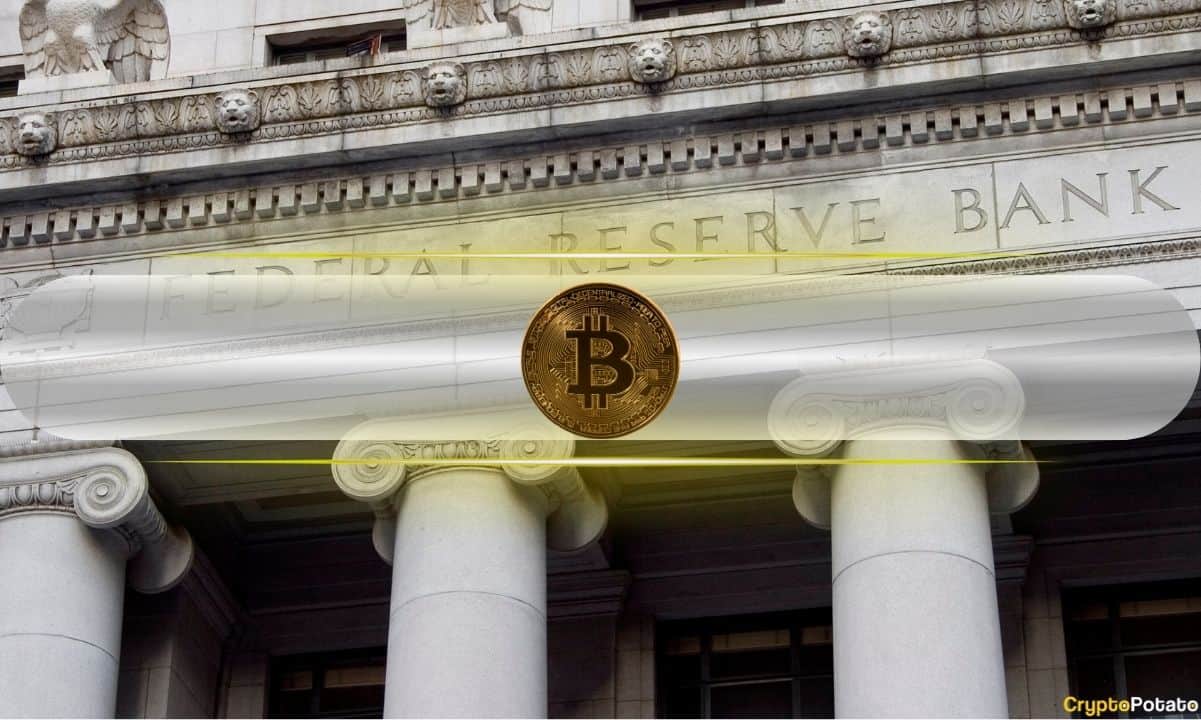Cryptocurrency
Fed’s Recession Fears Could Catapult Bitcoin Prices to $1M By 2030

Powell warned Wednesday, Apr. 16 of a stagflationary situation ahead with “higher inflation and slower growth.” He said the scenario would be “challenging” for the central bank to make policy decisions.
The Fed chair said there would be tension between the central bank’s twin mandates from Congress: maximum productive employment with minimum consumer price inflation.
Meanwhile the New York Federal Reserve’s Treasury yield curve recession indicator gives a 56% chance of the US economy going into recession in July.
Economic Fears Could Catalyze Bitcoin’s Trajectory to $1 Million
In Q1, BlackRock’s crypto chief Robbie Mitchnick said while speaking with Yahoo Finance, “A recession would be a big catalyst for Bitcoin.”
“It’s long liquidity, meaning it benefits from increased fiscal spending, deficit accumulation, and lower interest rates—all typical features of a recessionary environment,” Mitchnick said.
The inflationary recession the US central bank fears may be the catalyst that launches Bitcoin to the stratospheric $1 million forecast Block and CashApp founder Jack Dorsey made for by 2030.
Here are five ways markets expect that to happen:
1. There Are No Tariffs on Cryptocurrency
There are no tariffs on Bitcoin.
— Michael Saylor (@saylor) April 3, 2025
Unlike imported steel and manufactured items, there are no Trump Administration tariffs for Bitcoin or cryptocurrencies on the table. Bitcoin is an amorphous global Web3 layer network that exists in a borderless cyberspace.
Javier Molina, market analyst for the eToro trading brokerage platform, said in mid-April:
“Right now Tesla, Apple, and Google are showing more volatility than bitcoin, because that’s where the tariffs have a direct impact.”
US import tariffs slow the exchange of dollar exports in exchange for foreign materials and manufactured goods. As a result, countries that import fewer dollars may opt to import Bitcoin instead.
2. National and Corporate BTC Stockpiles Race
In fact, the US government’s own official stockpile plans have launched an international land grab for the scarce supply of remaining Bitcoin, capped at 21 million.
Fortune Magazine reported on Thursday that Binance is in talks with several world powers to help them implement sovereign Bitcoin funds.
Meanwhile, a Trump White House official even discussed an idea in April with Anthony Pompliano to use tariff revenue to buy Bitcoin for the US strategic national reserve. These shifts are tectonic in the scale of their implications for present market valuations.
Following in the wake of US leadership and Strategy’s successes, corporate balance sheets and whale-sized BTC addresses began accumulating Bitcoin like never before in Q1.
3. Fed Rate Cuts God Candle Bitcoin’s Price
Yes pic.twitter.com/m3wfn7802r
— Simply Bitcoin (@SimplyBitcoinTV) April 18, 2025
Furthermore, if Trump’s trade war leads to a slowing economy and rising prices, keeping Powell occupied at the moment, it could be another tsunami for Bitcoin’s price, with entrenched support levels locked in at the historical factor of 10 times on a roughly 4-year market cycle.
The financial crisis-era Fed rate cuts to nearly 0% in 2009 saw Bitcoin’s price move from $0.003 in 2010 to $469 in December 2015, when the central bank began raising rates again.
The global asset price crash in 2020, followed by emergency rate cuts to 0% in May 2020, launched Bitcoin’s price again from $5,245 on Mar. 18, 2020, to $66,953 in Nov. 2021.
Then, after pulling back for three months, Bitcoin immediately continued revising ruthlessly downward following the Fed’s pivot to rate hikes in Mar. 2022. That took markets to below $16,000 before the year was over.
Later, as the Fed started trimming rates down again in September 2024, like clockwork, Bitcoin’s price rallied to historic record high levels.
A slowing economy would likely prompt the printing press to target lower interest rates that ease lending to get businesses moving again. This has historically had the effect of pushing prices up for consumers, stock traders, and Bitcoin buyers.
4. US Fiscal Deficits Are Rocket Fuel For BTC
The Congressional Budget Office expects the US yearly national deficit in tax revenue to cover spending to continue to grow from its current record proportions. The CBO also predicts the national debt will be 156% of GDP by 2055.
There is a direct correlation since 1980 between US recessions and federal deficit spending rising to and becoming entrenched at new record high levels, according to data published by the St. Louis Federal Reserve.
Washington deficit spending levels also historically trend with Bitcoin prices because the government hogs up credit markets, creating upward pressure on loan rates that brings on more of the Fed’s printing press to keep business flowing.
5. Easy Dollars Make Hard Bitcoin More Dear In Recessions
Bitcoin’s world-historically disruptive growth as an independent Internet currency seems to exemplify the economic principle expressed by Gresham’s Law:
“Bad money drives out good from circulation.”
Thomas Gresham, who founded the Royal Exchange of the City of London in the 16th Century, noticed a pattern in the circulation of metal coins off the mint.
During uncertain times, merchants would spend and deposit the coins that were easier to make, like copper and silver, but hoard the most difficult coins, like gold.
International currency economists found the same pattern in free-floating global currency exchanges in the 20th century monetary era as central banks adjusted supplies and loan rates.
While dollars are easy for the Fed to make as long as the economy has the capacity to grow production to cover its loans, BTC is very hard to make, but demand for it continues to grow.
Bitcoin’s price was up 37% on the 12-month window the week ending Friday, Apr. 18. Meanwhile, the high-growth, tech-focused Nasdaq Composite was up 4.39% on a one-year basis.
Binance Free $600 (CryptoPotato Exclusive): Use this link to register a new account and receive $600 exclusive welcome offer on Binance (full details).
LIMITED OFFER for CryptoPotato readers at Bybit: Use this link to register and open a $500 FREE position on any coin!
Cryptocurrency
Ethereum Foundation, Whales, and Hackers: What’s Driving the ETH Sell-Off?

TL;DR
- Whales, hackers, and the Ethereum Foundation wallets moved over $500M in ETH through large sales and withdrawals.
- Ethereum transfers rose to 4.6M ETH, nearing the monthly high of 5.2M recorded in July.
- Staking inflows hit 247,900 ETH, the highest in a month, locking more supply from trading.
Large Withdrawals and Whale Activity
Ethereum (ETH) has seen heavy movement from major wallets over the past few days. On-chain data from Lookonchain shows a newly created wallet pulled 17,591 ETH, worth $81.62 million, from Kraken in just two hours.
Over three days, two new wallets withdrew a combined 71,025 ETH, valued at $330 million, from the exchange.
One of these wallets, address 0x2A92, has withdrawn 53,434 ETH, worth $242.34 million, in two days. This includes a recent purchase of 30,069 ETH, valued at $138.46 million, during a market drop.
Major ETH Holders Offload Millions Amid Price Rally
In contrast, several separate entities have been disposing of some ETH holdings. A wallet tied to a hacker address 0x17E0 sold 4,958 ETH for $22.13 million at $4,463, securing a profit of $9.75 million. Earlier this year, the same address sold 12,282 ETH at $1,932 and later bought back part of the amount at higher prices.
A different whale sold 20,600 ETH for $96.55 million over the past two days, generating a profit of more than $26 million after holding the position for nine months.
Meanwhile, an Ethereum Foundation-linked wallet, 0xF39d, sold 6,194 ETH worth $28.36 million in the last three days at an average price of $4,578.
Recent sales from the same wallet included an additional 1,100 ETH and 1,695 ETH for over $12.7 million combined.
The #EthereumFoundation-linked wallet(0xF39d) sold another 1,300 $ETH($5.87M) at $4,518 ~11 hours ago.
Over the past 3 days, this wallet has sold a total of 6,194 $ETH($28.36M) at an average price of $4,578.https://t.co/4hfCWymHVG pic.twitter.com/ErUyEY8SJy
— Lookonchain (@lookonchain) August 15, 2025
Network Activity on the Rise
CryptoQuant data shows Ethereum’s total tokens transferred have been climbing since August 9. After ranging between 1 million and 3 million ETH through late July and early August, transfers have risen to 4.6 million ETH, approaching the monthly high of 5.2 million recorded in mid-July. This increase has occurred alongside a price rally from about $3,400 to $4,600.
Interestingly, staking inflows generally stayed between 20,000 and 80,000 ETH per day over the past month. On August 14, inflows jumped to 247,900 ETH, the highest in the period.
At the time, ETH was trading near $4,600. Large staking deposits reduce the amount of ETH available for immediate trading, as staked coins are locked for a set period.
In the meantime, ETH trades at $4,647 with a 24-hour volume of $68.25 billion, down 2% on the day but up 19% over the week.
Binance Free $600 (CryptoPotato Exclusive): Use this link to register a new account and receive $600 exclusive welcome offer on Binance (full details).
LIMITED OFFER for CryptoPotato readers at Bybit: Use this link to register and open a $500 FREE position on any coin!
Cryptocurrency
Massive DOGE Whale Activity Hints at $1 Breakout

TL;DR
- Whales bought two billion DOGE this week, lifting their combined holdings to 27.6 billion coins.
- A single 900M DOGE transfer worth $208M to Binance drew attention to large exchange movements.
- DOGE broke key resistance, with momentum building for a possible push toward the $1 price mark.
Price and Market Moves
Dogecoin (DOGE) traded at $0.23 at press time, slipping 4% over the past day but still showing a 2% gain for the week. Daily turnover came in at about $6.18 billion.
Meanwhile, the broader crypto market saw over $1 billion in liquidations. Hotter-than-expected US Producer Price Index data pushed traders to scale back expectations of a near-term Federal Reserve rate cut. DOGE had roughly 290,500 coins liquidated during the sell-off.
On the two-week chart, analyst Trader Tardigrade notes that DOGE has cleared a downward-sloping resistance line after completing what appears to be a “wave V” in an Elliott Wave sequence. Similar setups in the past, where prolonged declines stayed within falling channels before breaking higher, have been followed by sharp rallies.
$Doge/2-week#Dogecoin is gaining strong momentum to surge above $1 pic.twitter.com/TuSEKr19nv
— Trader Tardigrade (@TATrader_Alan) August 15, 2025
Momentum gauges are also turning up. The Stochastic RSI, which had dropped into oversold territory, is now heading higher. Previous reversals from this zone have coincided with sustained upward moves. The current formation points to a possible run that could carry DOGE past the $1 mark.
Heavy Whale Buying and Large Transfers
As reported by CryptoPotato, blockchain data shows large investors have added two billion DOGE in the past week, spending just under $500 million. That brings their holdings to about 27.6 billion coins, or 18% of the supply. The buying streak has prompted speculation within the community.
Recently, Whale Alert flagged a 900 million DOGE transfer worth about $208 million into Binance. The tracking indicates that it originated from a wallet connected to the exchange, likely as an internal activity. The address involved holds 2.88 billion DOGE, one of the largest balances on the network.
Ali Martinez also reports that transactions above $1 million reached a one-month high, with activity building since early August and peaking as DOGE traded at $0.25.
Whales are back! Dogecoin $DOGE activity at a 1-month high. pic.twitter.com/C83Pv68mCt
— Ali (@ali_charts) August 14, 2025
Sentiment Building
Analyst Gordon described the current setup as “a nice bit of consolidation” before a potential breakout, adding,
“This will be one of the first coins normies FLOCK to & the pump will be MASSIVE.”
With whale accumulation rising, high-value transfers increasing, and a bullish technical pattern in play, DOGE is positioned for a potential push toward $1 if momentum holds.
Binance Free $600 (CryptoPotato Exclusive): Use this link to register a new account and receive $600 exclusive welcome offer on Binance (full details).
LIMITED OFFER for CryptoPotato readers at Bybit: Use this link to register and open a $500 FREE position on any coin!
Cryptocurrency
Ripple Price Analysis: XRP at Risk as Key Support Levels Could Trigger Sharp Drop

XRP has recently entered a consolidation phase after a strong rally earlier this summer, with the price action now hovering around key resistance levels on both its USDT and BTC pairs. Yet, while momentum has slowed, the charts still indicate a generally bullish structure, with multiple key support levels remaining firmly in place.
Technical Analysis
By ShayanMarkets
The USDT Pair
On the XRP/USDT daily chart, the price is currently trading near the $3.10 mark, facing a strong resistance zone around $3.40. This follows a breakout above the $2.70 range in July, which has now flipped into a support area.
Both the 100-day and 200-day moving averages are also trending upward and recently formed a bullish crossover around $2.45, reinforcing the medium-term bullish sentiment. If the $3.40 resistance breaks, a push toward the critical $4.00 range becomes likely.
However, the RSI hovering near the neutral 50 level suggests a lack of strong momentum for now, meaning a short-term pullback into the $2.80 support zone is still possible.
This zone will be key for maintaining the bullish structure. Losing it could open the door for a deeper correction toward the 200-day moving average located around the $2.40 mark. Yet, as long as the price stays above the moving averages, the broader trend remains bullish.
The BTC Pair
Looking at the XRP/BTC chart, the pair has recently pulled back after hitting the 3,000 SAT resistance, with the price currently around 2,600 SAT.
This follows a clean breakout above the long-term descending channel and a successful retest of its upper boundary, which coincided with the 200-day moving average and the 2,400 SAT support zone. This confluence remains a key bullish technical factor, as holding above it could attract renewed buying pressure.
That said, RSI levels around 48 show that momentum has cooled after the sharp July rally, meaning XRP may continue ranging between 2,400 SAT and 3,000 SAT in the near term. A decisive close above 3,000 SAT would likely open the path to the 3,400 SAT zone, while losing 2,400 SAT could shift the bias back toward 2,000 SAT support. For now, the structure still favors the bulls as long as higher lows remain intact.
Binance Free $600 (CryptoPotato Exclusive): Use this link to register a new account and receive $600 exclusive welcome offer on Binance (full details).
LIMITED OFFER for CryptoPotato readers at Bybit: Use this link to register and open a $500 FREE position on any coin!
Disclaimer: Information found on CryptoPotato is those of writers quoted. It does not represent the opinions of CryptoPotato on whether to buy, sell, or hold any investments. You are advised to conduct your own research before making any investment decisions. Use provided information at your own risk. See Disclaimer for more information.
Cryptocurrency charts by TradingView.

 Forex3 years ago
Forex3 years agoForex Today: the dollar is gaining strength amid gloomy sentiment at the start of the Fed’s week

 Forex3 years ago
Forex3 years agoUnbiased review of Pocket Option broker

 Forex3 years ago
Forex3 years agoDollar to pound sterling exchange rate today: Pound plummeted to its lowest since 1985

 Forex3 years ago
Forex3 years agoHow is the Australian dollar doing today?

 Cryptocurrency3 years ago
Cryptocurrency3 years agoWhat happened in the crypto market – current events today

 World3 years ago
World3 years agoWhy are modern video games an art form?

 Commodities3 years ago
Commodities3 years agoCopper continues to fall in price on expectations of lower demand in China

 Economy3 years ago
Economy3 years agoCrude oil tankers double in price due to EU anti-Russian sanctions

























